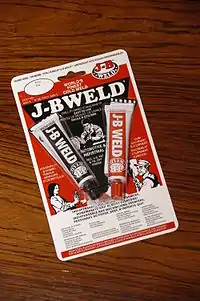J-B Weld
The J-B Weld Company is an international company that produces epoxy products. The home office is based in Sulphur Springs, Texas.[1] J-B Weld (stylized as J-B WELD) is the name of their flagship product: a specialized, high-temperature epoxy adhesive for use in bonding materials together. The company has run advertisements showing engine block repair with J-B Weld.[2]

History
The company had its beginnings in 1969[3] in Sulphur Springs, Texas. Sam Bonham, at the time running a machine shop, discovered a way to create what he called a "tougher than steel" epoxy.[3] In 1968, Sam's future wife Mary persuaded him to sell his invention and he founded the J-B Weld Company. Sam died suddenly in 1989. He had commented before his death, "My life's dream is for J-B Weld to be all the way around the world, and for me to see an 18-wheeler load out of here with nothing but J-B Weld."[3] Within a year of his death, Mary had opened a European hub in London, internationalizing the J-B Weld Company and the distribution of the product.[3]
Initially, the company sold to automotive shops and jobbers in Texas.[3] Now, the J-B Weld Company distributes its products through multiple retail channels - including automotive chains, home improvement centers, hardware stores, and farm stores[1] - and does business in all states in the United States, as well as in 27 other countries.[3]
Products
The J-B Weld Company's original product line focused on a small number of products: J-B Weld (original 2-tube epoxy), J-B Kwik (4-hour epoxy), J-B Stik (epoxy putty), Waterweld (underwater adhesive/filler), and a few others.[4]
Since 2008, the company has broadened the product line to add J-B SteelStik, KwikWood, PlasticWeld, MarineWeld, Perm-O-Seal, WoodWeld and ClearWeld.[5][6]
J-B Weld epoxy
J-B Weld is a two-part epoxy adhesive (or filler) that can withstand high-temperature environments. J-B Weld can be used to bond surfaces made from metal, porcelain, ceramic, glass, marble, PVC, ABS, concrete, fiberglass, wood, fabric, or paper.[7][8] Alcohol should be avoided when cleaning surfaces, as it can degrade the bond.[9] J-B Weld is water-resistant, petroleum/chemical-resistant (when hardened), and acid-resistant. It also resists shock, vibration, and extreme temperature fluctuations.[8] J-B Weld can withstand a constant temperature of 500 °F (260 °C), and the maximum temperature threshold is approximately 600 °F (316 °C) for 10 minutes.[9] J-B Weld can also be used inside a microwave oven, exposed to microwave radiation instead of infrared radiation (heat).[7]
The product is contained in 2 separate tubes: the "steel" (black tube of resin) and the "hardener" (red tube). Equal amounts are squeezed from both tubes and mixed.[7] For the best bond, surfaces should be roughened (or scratched) with fine or coarse sandpaper.
When first mixed, J-B Weld is subject to sagging or running (slow dripping), more so at warmer temperatures.[2][7] After about 20 minutes the mixture begins to thicken into a putty that can be shaped (with a putty knife or wooden spatula).[7] The mixture will set enough for the glued parts to be handled within 4–6 hours,[7] but requires up to 15 hours (at cool temperatures) to fully cure and harden. Temperatures above 50 °F (10 °C) shorten all these times.[7] After the initial setting period of a few hours, a heat (e.g. from a heat lamp or incandescent light bulb placed near the bond) will speed the curing time.[2][7] Before the initial setting period additional heat will induce a decrease in viscosity, which could result in sag or drip.
J-B Weld can be used as an adhesive, laminate, plug, filler, sealant, or electrical insulator.[8] When fully cured, J-B Weld can be drilled, formed, ground, tapped, machined, sanded, and painted.[8]
While J-B Weld Original epoxy dries to a dark grey color,[10] J-B Weld's ClearWeld epoxy dries clear. [11] Although its bond is not quite as strong as the Original's (3900 psi vs. 5020 psi),[12] ClearWeld is often preferred when appearance is an important consideration.[13]
J-B Kwik epoxy
J-B Kwik (stylized as J-B KWIK) is a two-part epoxy, intended as an adhesive or filler, that can withstand medium-temperature environments (up to 300 °F or 149 °C).[14]
J-B Kwik cures much more quickly, but it is not as strong or as heat-resistant as the original J-B Weld.[2][14] However, J-B Kwik has the same adhesion (1,800 psi or 12 MPa) as J-B Weld, and also does not shrink when hardening.[14]
J-B Kwik can be used to bond surfaces made from any combination of iron, steel, copper, aluminum, brass, bronze, pewter,[14] plus porcelain, wood, ceramic, glass, marble, PVC, ABS, concrete, fiberglass, fabric, or paper.[8][14] J-B Kwik is waterproof, petroleum/chemical-resistant (when cured), acid-resistant; plus resists shock, vibration, and extreme temperature fluctuations.[8]
See also
References
- https://www.jbweld.com/contact. Missing or empty
|title=(help) - Gomez, Sleepy (2009). "StockcarR-411 Radiator Repair". Stock Car Racing. Archived from the original on February 15, 2012. Retrieved March 26, 2015.
- "About J-B Weld Company", ChemicalWIKI.com, 2020, https://chemicalwiki.com/j-b-weld-incorporated/ JB-WELD about]
- "J-B Weld Company - Products Overview", JBWeld.net, 2004, JBWeld-products.
- "Featured Entrepreneur: Mary Bonham". constantcontact.com. Building Bridges Newsletter. Summer 2013. Retrieved March 26, 2015.
- Sampson, William (September 16, 2013). "In the Shop: Wood repair products from J-B Weld". www.fdmcdigital.com. CabinetMakerFDM. Retrieved March 27, 2015.
- "J-B Usage Instructions", JBWELD.net, 2004, JBWELD-use.
- "Repair Products UK Ltd: Metal Glue - J-B Weld", Repair Products UK Ltd, 2009,RProducts-42.
- "Frequently Asked Questions", JBWELD.net, 2004, JBWELD-faq.
- JBWELD-faq
- https://www.jbweld.com/product/clearweld-syringe
- compare https://www.jbweld.com/product/clearweld-syringe vs. https://www.jbweld.com/product/j-b-weld-twin-tube
- http://knowhow.napaonline.com/know-notes-use-jb-weld-clearweld/
- "J-B KWIK Product Information", JBWeld.net, 2009, JBKwik.